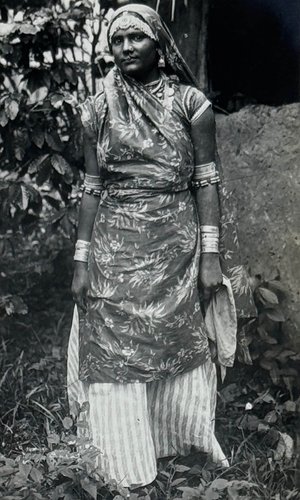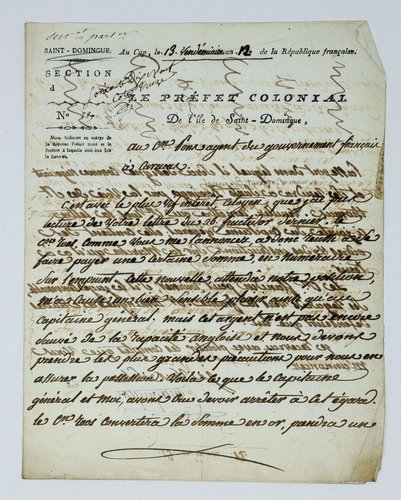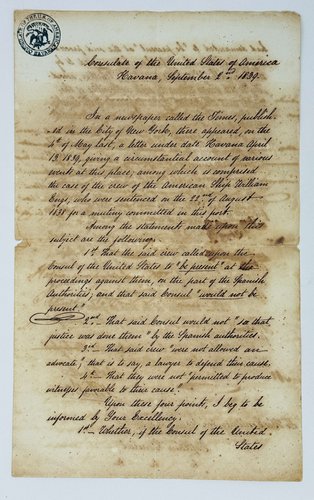

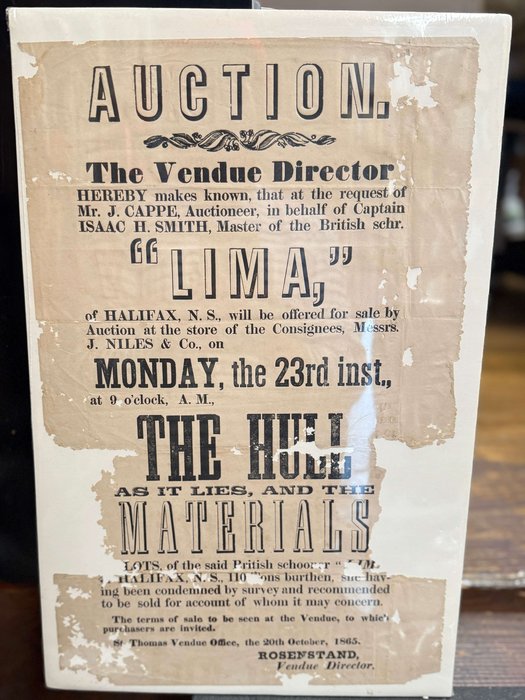
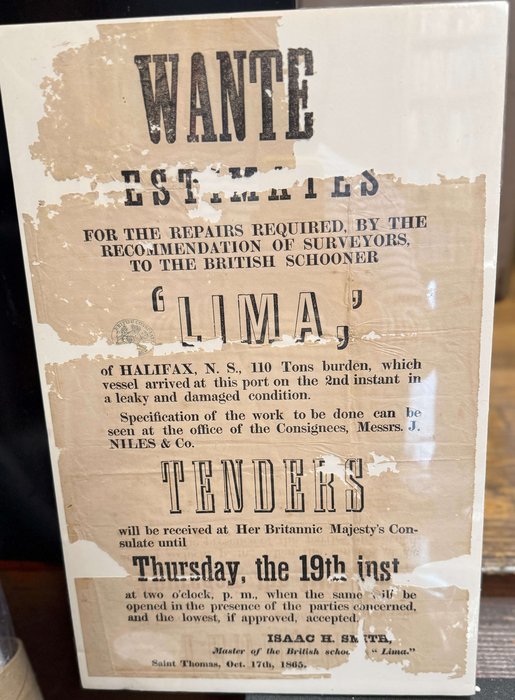
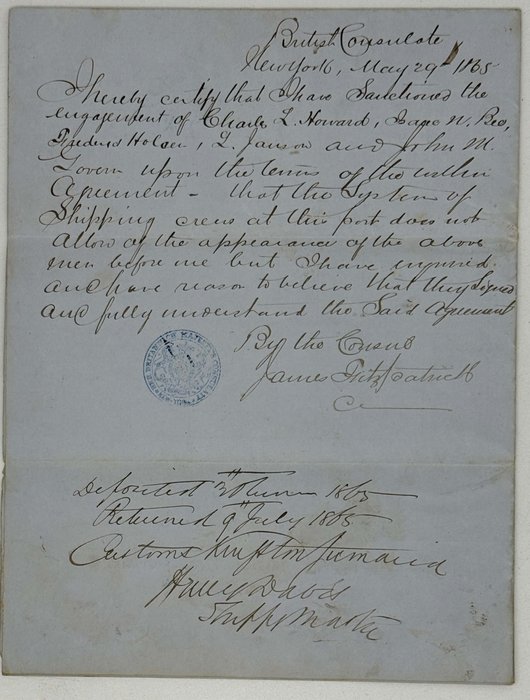
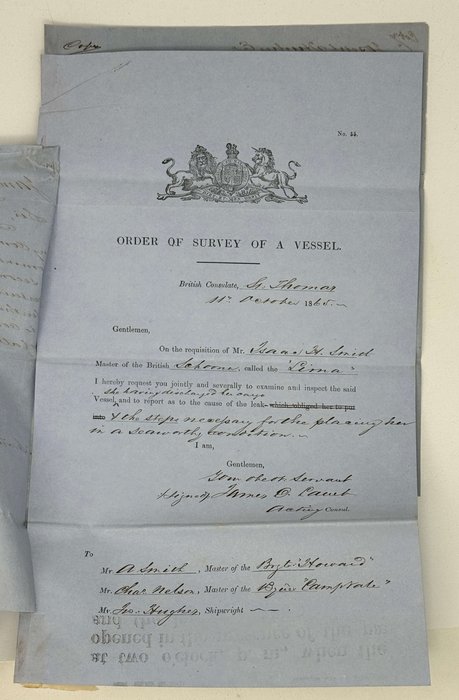
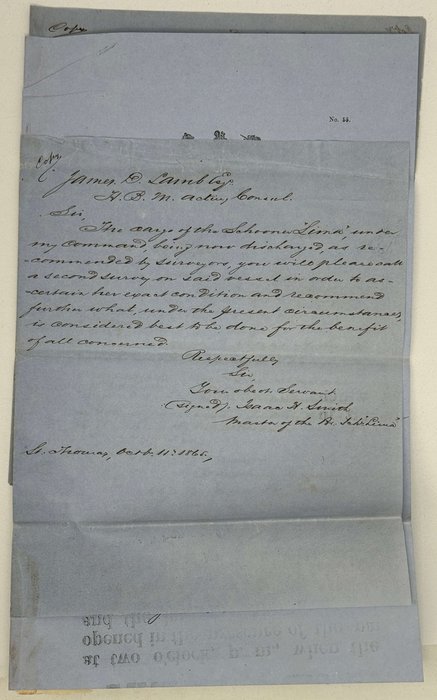


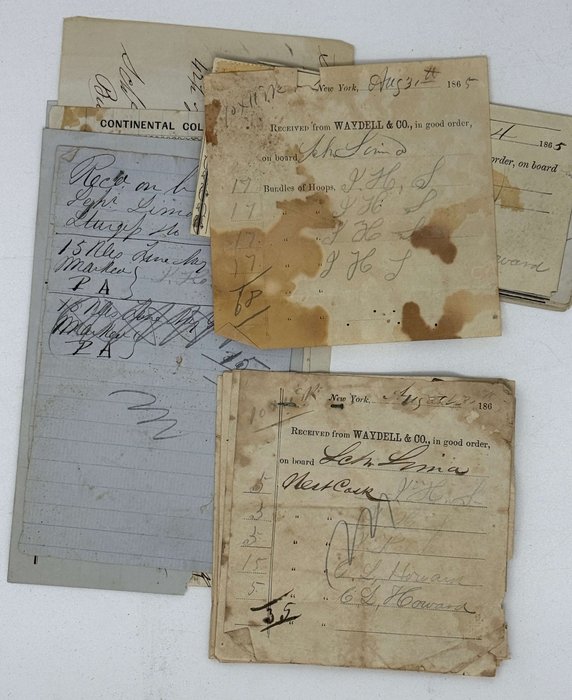
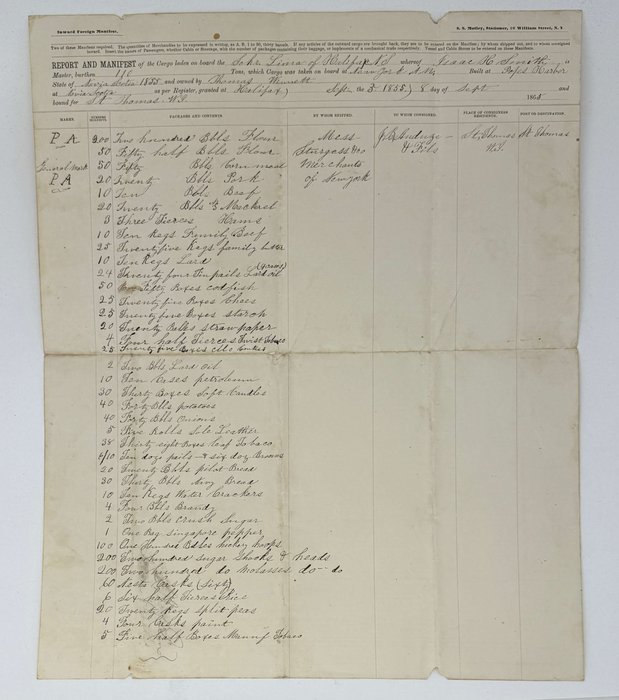
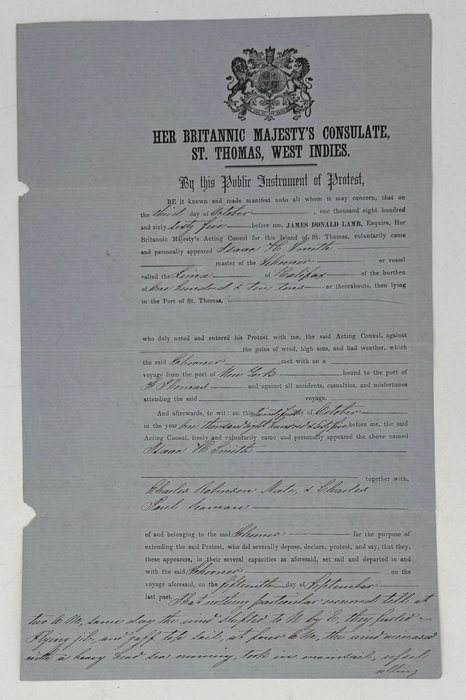
#MC60
Ca. 1865 – early 1866
Ca. 26 period manuscript copies and original receipts, reports, orders and statements (many folding, eight with official printed letterheads, several documents copied on leaves assembled in stubs), from ca. 53x40,5 cm (20 ¾ x16 in) to ca. 17x11 cm (6 ¾ x 4 ¼ in). In all ca. 36 pp. With two printed auction broadsides, each ca. 45x28,5 cm (17 ½ x 11 ¼ in); one with an ink stamp of the British Consulate in St. Thomas. With over thirty receipts from New York merchants (printed forms, filled in hand or manuscripts, dated August-September 1865), from ca. 11,5x21,5 cm (4 ½ x 8 ½ in) to ca. 7x13,5 cm (2 ½ x 5 ½ in); several assembled together and fastened with metal pins. With an autograph letter signed to “William H. Gibbs, Esq., Turk Island,” dated “New York, Sept. 6/1865” (ca. 26,5x20,5 cm or 10 ½ x 8 ½ in; 1 p., with the original envelope). With two period envelopes, inscribed “Capt. Isaac H. Smith, Schr. “Lima”” (ca. 9,5x21 cm or 3 ¾ x 8 ¼ in) and “Br. Schr. “Lima,” Bills of lading & shipping receipts of Captain” (ca. 11,5x26 cm or 4 ¼ x10 ¼ in). With a printed business card of “J. Niles & Company, Commission Merchants and Ship Agents, St. Thomas, W.I.” (ca. 6x9 cm or 2 ¼ x 3 ½ in). With two 1890s envelopes addressed to “Mrs. R.N. S. Smith, Harwich, Mass.” and “Mrs. William W. Cook, Harwich, Mass.” The auction broadsides with losses, affecting the text, the documents with foldmarks, creases, occasional tears and losses on the extremities, but overall a very good collection.
Interesting extensive archive of original manuscripts, printed documents and period copies, providing an insight into the New York merchants’ trade in the Caribbean shortly after the Civil War (April 12, 1861 – April 9, 1865). Most documents were created or copied in St. Thomas City (Charlotte Amalie), then the capital of the Danish West Indies – a trade hub of the Caribbean at the time, largely due to very low customs duties. This and the strategic geographical position of the archipelago led to the proposition of American President Andrew Johnson to purchase it from Denmark in 1867, but the deal wasn’t approved by the U.S. Senate. The second round of negotiations took place during WW1, and in 1917, Danish West Indies became the United States Virgin Islands.
The archive concerns the “British” (Canadian-built) wooden schooner “Lima,” launched in Popes Harbour, Nova Scotia, in 1855, and registered in the port of Halifax (Ship Registrations database, 1878-1966/ Library and Archives Canada; see more). As follows from the documents in the collection, during its 10-years life, “Lima” carried out trade voyages between New York, Jamaica and St. Thomas, being manned and commanded by Americans. The captain of its last voyage, who created or was mentioned in most documents from the collection, was most likely Isaac H. Smith (1824-1911), a native of Harwich, Cape Cod, Massachusetts. The archive includes an envelope, addressed to “Mrs. R.N. S. Smith, Harwich, Mass.” – most likely, Ruth Nickerson Smith (1827-1903), Captain Smith’s wife.
During her last voyage from New York to St. Thomas on September 15 – October 2, 1865, “Lima” encountered heavy weather, and started to leak seriously; later the waves “parted the gammon of bowsprit, spliting the head rail and doing other damage.” After its arrival to St. Thomas, the schooner was “condemned at that port” (Shipping News// New York Daily Herald. November 11, 1865, p. 8), its cargo was removed and sold, and the ship’s hull and fittings sold at a local auction for $764.14 (on October 23). The archive documents the history of “Lima’s” voyages in 1865, focusing on the last one and the proceedings of its inspection and sale in St. Thomas.
The collection includes a large folding “Report and Manifest” of “Lima’s” cargo during its last voyage, “laden on board” in New York on September 3, 1865. The document lists over thirty positions, including flour, corn meal, beef, pork, mackerel, ham, lard, “chees,” starch, straw paper, tobacco, candles, petroleum, potatoes, onions, sole leather, “ten doz. pails & six doz. brooms,” bread, water crackers, brandy, “crush sugar,” Singapore peppers, “hickery hoops,” molasses, rice, split peas, paint, &c. The “Report” is backed by over thirty cargo receipts from New York merchants, loaded onto the “Lima” on August 29 – September 6, 1865 (from “Waydell & Co.,” Sturges & Co.,” “Raynolds, Pratt & Co.,” “J.C. Hull’s Son’s,” “ “Bullard & Co.,” and “Lobwer, Ostrom & Co.”). An autograph letter from New York (September 6, 1865), addressed to “William H. Gibbs, Esq., Turk Island” (then a Jamaican dependency), further details on “Lima’s” voyage and cargo load: “This will be handed by Capt. Smith of Schr. Lima, whom we commanded to call on you for a cargo of salt. We have assured him that you will [permit?] him with a cargo on the best possible terms & give him quick dispatch…” There is also a large folding crew list and agreement between the captain and five crew members, with the entries dated “New York, May 23-28, 1865.” Two notes by the officials from the British consulate in New York on the verso of the document certify it on May 29 and September 7, 1865.
A large, three-paged document on the printed form of the British consulate in St. Thomas, West Indies, is a “Public Instrument of Protest,” completed on October 3, 1865, the next day after “Lima’s” arrival to the island. The document lists “Isaac H. Smith, master of the schooner,” “Charles Robinson, mate & Charles Paul, seaman” as claimants and contains a detailed account of “Lima’s” last voyage and the damage endured in rough seas. The last page has a signature and official seal of James Donald Lamb, acting British Consul in St. Thomas.
The archive also includes three copies of Captain Smith’s letters to James D. Lamb, asking to conduct a survey of “Lima” “in order to ascertain her exact condition” and recommend further actions with the vessel, supplemented with official “Orders of survey of a vessel” and copies of letters of seamen who conducted the survey. It was concluded that “the vessel [to] be sold as she now stands at auction to the highest bidder…”
Two rare printed broadsides, dated “Saint Thomas, Oct. 17th, 1865” and “St. Thomas Vendue Office, the 20th October, 1865,” advertise the need for “Estimates for the Repairs” for “Lima” and then – the auction sale of the schooner’s hull and materials “at the store of the Consignees, Messrs. J. Niles & Co.” The archive contains a rare official receipt of “Lima’s” auction sale - “the hull as it lies, and the materials” (“1 lot of rope”, flour, stoves, “compass, leadlines, lamps,” “1 boat & oars”) in St. Thomas on October 23, 1865. The document is signed by “J. Cappe” (“the authorized Auctioneer of this place”) and British consul James D. Lamb, and bears an ink stamp of the British consulate and an embossed stamp of “St. Thomas Auction Rooms.”
In addition, there are six period duplicates of original receipts, given to Captain Isaan Smith during his stay in St. Thomas in October-November, 1865 (all signed by the subjects): from the local agent firm “J. Niles & Co.,” the printing office of John Benners, the customs house, British consul James D. Lamb and a hotel keeper “Mrs. E. Higgins.” The collection also includes two original cheques of “J. Niles & Co., St. Thomas, W.I.” for “$857.27c gold” (given to “Messrs. B.F. Small & Co.” on November 10, 1865 to present to “Messrs. Boyd & Hincken, New York.”) and a well-preserved printed business card of “J. Niles & Company, Commission Merchants and Ship Agents, St. Thomas, W.I.”
The remaining documents are a short manuscript statement regarding “Isaac H. Smith, in acct. with Br. Sch. Lima” compiled in “New York, March 21st, 1866” and a certificate of customs clearance, given to Captain Isaac Smith in Kingston, Jamaica, on July 11, 1865 (related to “Lima’s” earlier trade voyage).
Overall an interesting collection of early original and copied official papers, adding to the history of New York merchant voyages to the Danish West Indies - future United States Virgin Islands.
“The town of Charlotte Amalia, which is in fact the Island of St.Thomas, carries on an immense trade for so small a place. The population is about fourteen thousand. There are from forty to fifty merchants in the place who carry on a large wholesale trade in British and other European goods to all parts of the Spanish Main and the West India Islands, where the Royal Mail Company’s steamers do not go, and, as the import duty on all commodities is only one and a quarter per cent, and the merchants’ words taken, rendering invoices unnecessary, large profits are realized. This small duty is the only tax by which the local government is supported <…> A curious feature of social life in St. Thomas is the universality with which the English language is spoken, Danish being little understood, even by natives of the island” (Trip of the Steamship Havana to St. Thomas // New York Daily Herald, October 30, 1865, p. 1).













